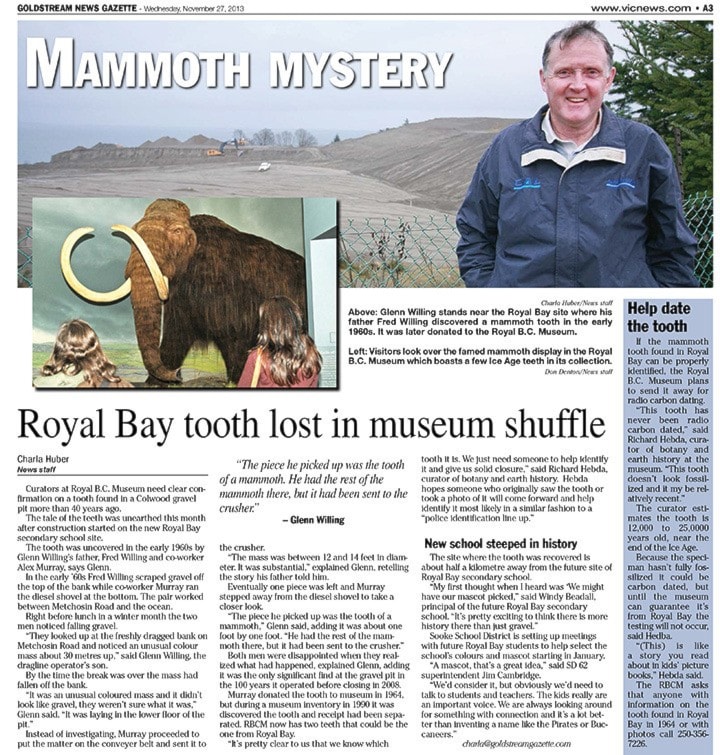Curators at Royal B.C. Museum need clear confirmation on a tooth found in a Colwood gravel pit more than 40 years ago.
The tale of the teeth was unearthed this month after construction started on the new Royal Bay secondary school site.
The tooth was uncovered in the early 1960s by Glenn Willing’s father, Fred Willing and co-worker Alex Murray, says Glenn.
In the early ’60s Fred Willing scraped gravel off the top of the bank while co-worker Murray ran the diesel shovel at the bottom. The pair worked between Metchosin Road and the ocean.
Right before lunch in a winter month the two men noticed falling gravel.
“They looked up at the freshly dragged bank on Metchosin Road and noticed an unusual colour mass about 30 metres up,” said Glenn Willing, the dragline operator’s son.
By the time the break was over the mass had fallen off the bank.
“It was an unusual coloured mass and it didn’t look like gravel, they weren’t sure what it was,” Glenn said. “It was laying in the lower floor of the pit.”
Instead of investigating, Murray proceeded to put the matter on the conveyer belt and sent it to the crusher.
“The mass was between 12 and 14 feet in diameter. It was substantial,” explained Glenn, retelling the story his father told him.
Eventually one piece was left and Murray stepped away from the diesel shovel to take a closer look.
“The piece he picked up was the tooth of a mammoth,” Glenn said, adding it was about one foot by one foot. “He had the rest of the mammoth there, but it had been sent to the crusher.”
Both men were disappointed when they realized what had happened, explained Glenn, adding it was the only significant find at the gravel pit in the 100 years it operated before closing in 2008.
Murray donated the tooth to museum in 1964, but during a museum inventory in 1990 it was discovered the tooth and receipt had been separated. RBCM now has two teeth that could be the one from Royal Bay.
“It’s pretty clear to us that we know which tooth it is. We just need someone to help identify it and give us solid closure,” said Richard Hebda, curator of botany and earth history. Hebda hopes someone who originally saw the tooth or took a photo of it will come forward and help identify it most likely in a similar fashion to a “police identification line up.”
New school steeped in history
The site where the tooth was recovered is about half a kilometre away from the future site of Royal Bay secondary school.
“My first thought when I heard was ‘We might have our mascot picked,” said Windy Beadall, principal of the future Royal Bay secondary school. “It’s pretty exciting to think there is more history there than just gravel.”
Sooke School District is setting up meetings with future Royal Bay students to help select the school’s colours and mascot starting in January.
“A mascot, that’s a great idea,” said SD 62 superintendent Jim Cambridge.
“We’d consider it, but obviously we’d need to talk to students and teachers. The kids really are an important voice. We are always looking around for something with connection and it’s a lot better than inventing a name like the Pirates or Buccaneers.”
Help date the tooth
If the mammoth tooth found in Royal Bay can be properly identified, the Royal B.C. Museum plans to send it away for radio carbon dating.
“This tooth has never been radio carbon dated,” said Richard Hebda, curator of botany and earth history at the museum. “This tooth doesn’t look fossilized and it my be relatively recent.”
The curator estimates the tooth is 12,000 to 25,0000 years old, near the end of the Ice Age.
Because the speciman hasn’t fully fossilized it could be carbon dated, but until the museum can guarantee it’s from Royal Bay the testing will not occur, said Hedba.
“(This) is like a story you read about in kids’ picture books,” Hebda said.
The RBCM asks that anyone with information on the tooth found in Royal Bay in 1964 or with photos call 250-356-7226.
